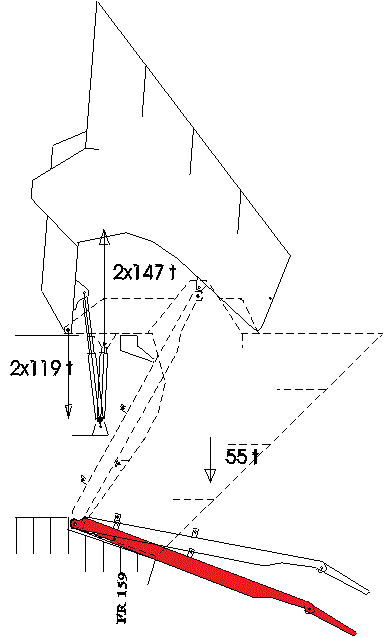3.3 The Function of the Visor
|
The function of the visor is very simple. The hydraulic locking pins are pulled out by remote control and the visor can be pushed up and be opened by two hydraulic pistons situated on deck 3 acting on the visor lifting arms connected to the deck hinges on deck 4 - see figure 3.3. To push up the visor you need initially a total force of the hydraulic pistons of abt. 293 tonnes (147 tonnes per piston). The force acting on each deck hinge is then about 119 tonnes, even if the hinge was designed to easily handle 350 tonnes. As the visor is lifted up, the required lifting force is reduced (as the bending moment in the lifting arm is reduced) and thus also the force on the hinge is reduced. The maximum force acting on each deck hinge - 119 tonnes - is applied, when the opening starts or the closing ends. Closing the visor is evidently the reverse operation. Just before the visor comes to rest on its supports, the maximum force on the deck hinge is again experienced. The load on the hinge becomes zero, when the visor rests on its supports. When the three visor locks are thereafter engaged, the visor should in principle have been pushed against the rubber seals around the visor and there should have been no clearances in the three locks, while there should have been a little clearance at and in the hinges. All the vertical (upward) load on the visor would then be transmitted only via the locks at sea and as friction in the rubber seals. If, for any reason - a mistake? - you try to lift open the visor, while the side locks are still locked - the lugs held in place by the pins - and the Atlantic lock is open, the lifting hydraulics are strong enough to rip off the visor lugs from the visor aft plate. You should also note the ramp in the above figure. During the accident we are told that the visor fell off and pulled the ramp fully open, thus the ramp was pushed down all the way against the forepeak deck. The forward speed was 14-15 knots. The forward/top end of the ramp was then in the waterline and the ramp would act like a plough forcing water straight into the superstructure. |
|
Or maybe the water below the ramp pushed the ramp up again, so that it closed? But what happened then when the bow was totally above water? Did the ramp fall down again?
The ramp is described in the next chapter.
---
